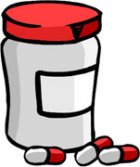
Worksheets and No Prep Teaching Resources
Reading Comprehension Worksheets
Drugs

Drugs
 Worksheets and No Prep Teaching Resources Reading Comprehension Worksheets Drugs |
 Drugs |
| edHelper's suggested reading level: | grades 5 to 7 | |
| Flesch-Kincaid grade level: | 7.35 |
|
Drug Education Introduction
By Jennifer Kenny |

|
 1 Are drugs good or bad for you? Well, that is certainly a question worthy of discussion since there's not a yes or no answer. Was that a trick question? Not exactly. Think about it. What do aspirin and cocaine have in common? They're both drugs. Drugs are chemical substances that cause changes, physical or emotional, in an individual. To go back to the first question then, drugs can be labeled good or bad depending on their purpose. Drugs used for medicine are meant to help sick people. People looking to change their brain functioning in an unhealthy way use drugs labeled as drugs of abuse.
1 Are drugs good or bad for you? Well, that is certainly a question worthy of discussion since there's not a yes or no answer. Was that a trick question? Not exactly. Think about it. What do aspirin and cocaine have in common? They're both drugs. Drugs are chemical substances that cause changes, physical or emotional, in an individual. To go back to the first question then, drugs can be labeled good or bad depending on their purpose. Drugs used for medicine are meant to help sick people. People looking to change their brain functioning in an unhealthy way use drugs labeled as drugs of abuse. |
Create Weekly Reading Books
Prepare for an entire week at once! |
| Leave your feedback on Drug Education Introduction (use this link if you found an error in the story) |
 |
Drugs
|